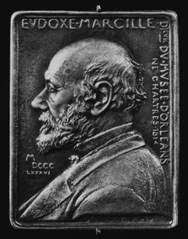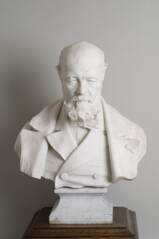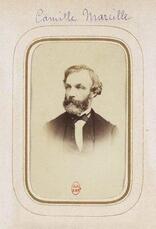The Marcille family
Strengthened by three complementary personalities, the Marcille Collection cannot be dissociated from the members of the Marcille family who each contributed to it, in order to forge its identity.
|
|
François Marcille was born in Orléans on the 7th of July 1790 within a family of landowners from Beauce. In 1814, he married Ermine Juteau with whom he had two children, Eudoxe born in 1814 and Camille in 1816. François Marcille was at first a seed merchant in Orléans, but progressively abandoned this flourishing profession to focus on his passion for art. He settled down rue de Bourbon (currently rue de Lille) in Paris in 1822, not far from the Louvre which he visited diligently in order to perfect his pictorial culture and sharpen his own practice by producing several copies of masterpieces. In Paris, he also discovered the gallery of Father Giraud who notably exhibited the paintings of a forgotten 18th century artist, Jean-Baptiste Greuze.
|
François Marcille would progressively develop a great admiration for this painter, whose paintings he would first copy before acquiring them, which would constitute the first artworks of a rapidly expanding collection. Indeed, little by little, this love of painting would become his main activity as he browsed through flea markets and sales, in which he did not focus on the most famous names but rather upon the artists reflecting his own sensibilities. Accompanied by Louis La Caze, also a zealous amateur who would notably discover Gilles de Watteau, he discovered La fuite à dessein (“The escape with intent”) by Fragonard. Without ever encountering true competition, the two friends each built up a singular collection composed of artists who would later on be recognised as major.
The rythm of acquisitions accelerated, until it reached the impressive number of forty paintings by Boucher, thirty by Chardin, twenty-five by Fragonard, eighteen by La Tour, fifteen by Porreneau, and in total more than 4 500 paintings of all origins and time periods.
In September 1856, shortly before his death, François Marcille proceeded to a random draw in order to divide up his collection between his two sons. François Marcille died in Paris, 9th November 1856.
The rythm of acquisitions accelerated, until it reached the impressive number of forty paintings by Boucher, thirty by Chardin, twenty-five by Fragonard, eighteen by La Tour, fifteen by Porreneau, and in total more than 4 500 paintings of all origins and time periods.
In September 1856, shortly before his death, François Marcille proceeded to a random draw in order to divide up his collection between his two sons. François Marcille died in Paris, 9th November 1856.
|
The eldest son of François and Ermine Marcille, Eudoxe, was born in Chartres on the 20th of April 1814. Thanks to his father, he thrived within an environment devoted entirely to fine art and would notably be taught by two of its luminaries: Eugène Devéria and Charles de Steuben. He pursued his studies at the Collège Stanislas in Paris.
He married Louise Erat-Oudet with whom he settled down at 54, rue d'Hauteville in the hôtel particulier of his step-family which had the notable advantage of a workshop-gallery. Less of an artist than his father was, Eudoxe nevertheless demonstrated the same enthusiasm for the acquisition of artworks. |
Eudoxe Marcille 1814 - 1879 Art patron and institutional |
 Oscar Roty, médaille gravée du buste d'Eudoxe Marcille, exemplaire de la collection du MET.
Oscar Roty, médaille gravée du buste d'Eudoxe Marcille, exemplaire de la collection du MET.
Every Monday, he would receive amateurs, like the frères Goncourt or the young Edgar Degas, as well as the families of the doctor Louis La Caze.
In March 1861, he became a member of the consulting commission of museums by nomination of the Ministry for public instruction. In October of the same year, he became the member of the jury for the Great Exhibition of London, in 1865, he was part of the jury for the annual Salons of engraving and then painting.
In 1870, he became director of the Musée d’Orléans where he gave a new dynamic to the existing collections, notably through a reworking of the scenography until then limited to presentations in rooms not adapted to the works on display, and by publishing catalogues referencing 1232 works, including 1088 from donations, strengthening the museum collection. His efforts attracted the recognition of his peers. In 1871, he was named President of the Society of the friends of the arts of Orléans, while acting as head of the School of drawing of the city, where the teaching provided was free. He then became a patron of the arts by entrusting his personal fortune within the service of emerging artists, like the sculptor Alfred Desiré Lanson (who made his portrait in 1880, today in the collection of the Musée d'Orléans) and Charles Desvergnes, both former students of the school which he directed. He was granted the rank of knight of the national order of the Légion d’honneur the 19th of April 1879.
In March 1861, he became a member of the consulting commission of museums by nomination of the Ministry for public instruction. In October of the same year, he became the member of the jury for the Great Exhibition of London, in 1865, he was part of the jury for the annual Salons of engraving and then painting.
In 1870, he became director of the Musée d’Orléans where he gave a new dynamic to the existing collections, notably through a reworking of the scenography until then limited to presentations in rooms not adapted to the works on display, and by publishing catalogues referencing 1232 works, including 1088 from donations, strengthening the museum collection. His efforts attracted the recognition of his peers. In 1871, he was named President of the Society of the friends of the arts of Orléans, while acting as head of the School of drawing of the city, where the teaching provided was free. He then became a patron of the arts by entrusting his personal fortune within the service of emerging artists, like the sculptor Alfred Desiré Lanson (who made his portrait in 1880, today in the collection of the Musée d'Orléans) and Charles Desvergnes, both former students of the school which he directed. He was granted the rank of knight of the national order of the Légion d’honneur the 19th of April 1879.
|
Camille Marcille 1816 - 1875 Artiste, collectionneur et conservateur |
Born on the 1st of May 1816 in Chartres, Camille benefited from the same artistic education as his brother Eudoxe. In 1854, he married Cécile Walckenaer, with whom he had three children. Together, they settled in Oisème, on the edges of Chartres. He notably received the frères Goncourt, Eugène Scribe and Jean-Baptiste Corot who painted now famous visions of the surroundings.
A member of the archeological society of Eure-et-Loire, Camille Marcille also became a member of the commission of curators of the Musée de Chartres from 1862 onwards, for which he was named president the 21st of January 1865. Both a curator and collector, Camille Marcille was also an artist, educated by the painters C.Steuben and A.Devéria. |
|
Just like his father, he first created numerous copies of works from the 18th century from within his collection. Certain works were exhibited in Salons between 1859 and 1869. The 3rd of August 1875, Camille Marcille passed away in his workshop. A year later, his important collection, composed of masterpieces from the 15th century to the 19th century, was put up for sale. The town of Chartres acquired four works: The Archangel by Raphaël de Lesueur, Saint Lucy by Fransisco Zubarán, The Delivery of Saint Peter by Sébastien Bourdon, the sketch of the painting depicting The Lesson by Prévost, to learn to paint panoramas by Léon Matthieu Cochereau. Numerous donations to the museum would then reinforce this collection.
|



